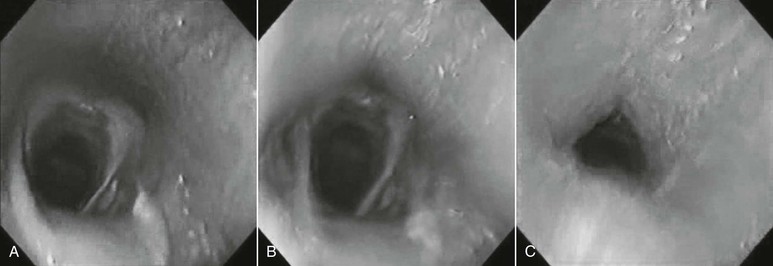Elizabeth J. Davidson
Pharyngeal Collapse
Nasopharyngeal collapse is a common cause of upper respiratory obstruction in racehorses, sport performance horses, and ponies. Affected horses exhibit abnormal upper respiratory noise and exercise intolerance. Nasopharyngeal collapse is a dynamic condition, occurring during exercise, and dynamic endoscopic examination is necessary for the correct diagnosis. Exercising endoscopy findings include dynamic collapse of one or more pharyngeal walls. Strictly speaking, intermittent dorsal displacement of the soft palate (DDSP) is the most common form of nasopharyngeal collapse and occurs when the caudal aspect of the soft palate (the ventral pharyngeal wall) displaces dorsal to the epiglottis and obstructs the upper airway (see Chapter 54). The term pharyngeal collapse (PC) is used to describe dorsal, lateral, or circumferential collapse of a pharyngeal wall or walls during exercising endoscopic examination. The terms soft palate instability, palatal instability, and palatal billowing are used to describe ventral instability or dorsoventral billowing of the soft palate. This condition may be observed as part of the DDSP complex, usually preceding DDSP or arising as a separate obstructive condition. As with all nasopharyngeal disorders, palatal instability is only apparent during exercise.
Pharyngeal Collapse
Medical history findings for horses with PC include poor performance and abnormal upper respiratory noise during exercise. Severely affected horses make a low frequency or roaring-like inspiratory noise. On the basis of retrospective analysis of treadmill endoscopic findings, the incidence is 3% to 20% in poorly performing racehorses. In sport performance horses, elevated head and neck carriage can further exacerbate clinical signs, and the disorder has been observed in up to 31% of show horses presented for treadmill endoscopy. Horses that are homozygous for hyperkalemic periodic paralysis are at risk for PC, especially those with stridor.
The etiology of PC is unknown but is thought to be associated with neuromuscular fatigue coupled with the large negative pressures that develop in the nasopharynx during high-speed exercise. Lacking bone or cartilage support, the nasopharynx integrity is sustained by the pharyngeal musculature. Contraction of these muscles results in dilation and stability of the nasopharynx. Within the nasopharyngeal mucosa, numerous sensory mechanoreceptors detect the large intraluminal pressure changes that occur during breathing. Increased activity of these receptors enhances activation of the pharyngeal muscles. Any dysfunction of this complex neuromuscular reflex may result in instability and dynamic collapse of the pharynx during exercise. Varying degrees of dynamic PC have been created by application of local anesthetic on the laryngeal mucosa. Dorsal pharyngeal wall collapse has also been produced following bilateral glossopharyngeal nerve anesthesia, which results in dysfunction of the stylopharyngeus muscle, a major dilator of nasopharynx. Guttural pouch tympany and DDSP have also been incriminated as contributors to the disorder.
Diagnosis
Even in affected horses, endoscopic findings are normal when the horse is at rest. In many horses, dorsal pharyngeal wall collapse is seen during the nasal occlusion maneuver. However, there is no correlation between this endoscopic observation in the resting horse and pharyngeal function during exercise. In fact, most of these horses will not exhibit PC during exercise. Interestingly, in one treadmill study, 66% of young Thoroughbreds that had difficulty repositioning a displaced soft palate during endoscopic examination at rest had PC during exercise. However, numerous other studies have failed to document a relationship between upper airway findings in the standing and exercising horse. In general, the diagnosis cannot be made on the basis of endoscopic examination in the resting animal.
Diagnosis of PC is confirmed by endoscopic evaluation of the upper airway during exercise. This examination may be performed on a treadmill or by use of overground endoscopy. Pharyngeal collapse is progressive, and worsens with increased exercise effort (Figure 55-1). At maximal speed, affected horses often have poor gas exchange (severe hypoxemia and hypercapnia), which explains the profound exercise intolerance in many of these animals. Pharyngeal collapse may be observed as a singular form of dynamic collapse or in conjunction with other obstructive disorders. In show horses, implementation of side reins to simulate flexed head and neck position may be necessary to accurately diagnose the condition. Corresponding abnormal inspiratory respiratory noise can also be appreciated, but abnormal sounds should not be used as the sole diagnostic criteria.

< div class='tao-gold-member'>
Stay updated, free articles. Join our Telegram channel

Full access? Get Clinical Tree


